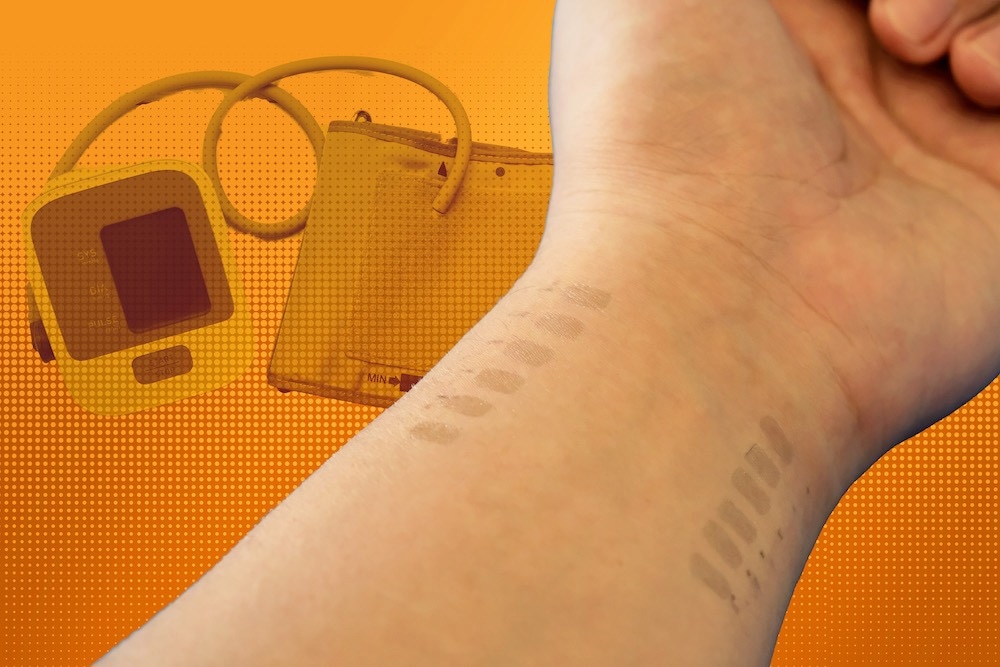
Image Credit: The University of Texas at Austin
The study has appeared in the journal Nature Nanotechnology.
High blood pressure can result in serious heart illnesses if left unchecked. It can be difficult to capture with a conventional blood pressure check because that just measures a moment in time, a single data point.
Taking infrequent blood pressure measurements has many limitations, and it does not provide insight into exactly how our body is functioning.
Roozbeh Jafari, Project Co-Leader and Professor of Biomedical Engineering, Computer Science, and Electrical Engineering, Texas A&M
The uninterrupted monitoring of the e-tattoo enables blood pressure measurements in all types of situations: during periods of high stress, while sleeping, while exercising, etc. It can provide thousands of measurements more than any other device so far.
Mobile health tracking has taken huge leaps in the last few years, mainly because of technology like smartwatches. These devices utilize metallic sensors that obtain readings based on LED light sources irradiated via the skin.
However, top smartwatches are still not ready for blood pressure tracking. That is because the watches tend to slide around on the wrist and might be far from arteries, making it hard to convey exact readings. Furthermore, the light-based measurements can waver in people with larger wrists and/or darker skin tones.
Graphene is one of the thinnest and strongest materials in existence, and it is a main component in the e-tattoo. It is comparable to graphite found in pencils, but the atoms are specifically organized into thin layers.
E-tattoos are more logical as a vehicle for mobile blood pressure tracking as they reside in a sticky, flixible material enclosing the sensors. They are comfortable to wear for a long time and do not slide about.
The sensor for the tattoo is weightless and unobtrusive. You place it there. You don’t even see it, and it doesn’t move. You need the sensor to stay in the same place because if you happen to move it around, the measurements are going to be different.
Roozbeh Jafari, Project Co-Leader and Professor of Biomedical Engineering, Computer Science, and Electrical Engineering, Texas A&M
The device captures its measurements by shooting an electrical current into the skin and then examining the body’s response, which is called bioimpedance. There is a relationship between bioimpedance and variations in blood pressure that has a link with blood volume variations.
However, the relationship is not particularly apparent, so the researchers had to develop a machine learning model to examine the connection to obtain precise blood pressure readings.
In the medical field, cuff-less blood pressure tracking is the “holy grail,” Jafari stated, but there is not a feasible commercial solution yet. It is part of a larger drive in the field of medicine to use technology to unstrap patients from machines while gathering more information wherever they are, enabling them to move from room to room, clinic to clinic, and still acquire tailored care.
All this data can help create a digital twin to model the human body, to predict and show how it might react and respond to treatments over time.
Deji Akinwande, Project Co-Leader and Professor, Department of Electrical and Computer Engineering, UT Austin
The project team members include Dmitry Kireev and Neelotpala Kumar of the Department of Electrical and Computer Engineering at UT Austin; Ali Akbari of the Department of Biomedical Engineering at Texas A&M; and Kaan Sel and Bassem Ibrahim of the Department of Electrical and Computer Engineering at Texas A&M. The study received support via grants from the National Science Foundation, Office of Naval Research, and National Institutes of Health.
Journal Reference:
Kireev, D., et al. (2022) Continuous cuffless monitoring of arterial blood pressure via graphene bioimpedance tattoos. Nature Nanotechnology. doi.org/10.1038/s41565-022-01145-w.